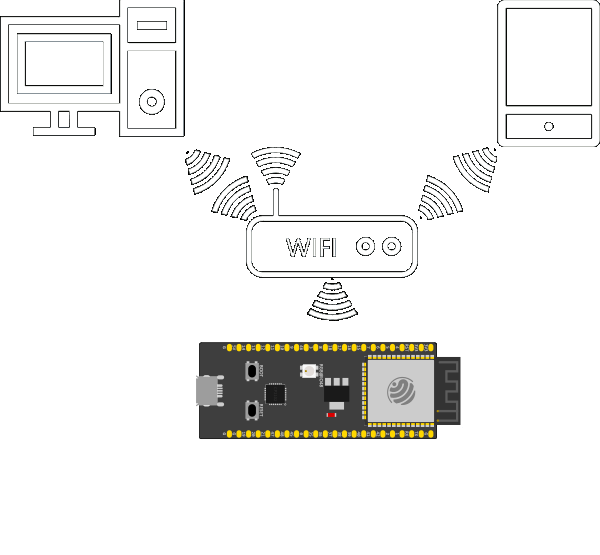Home / Tutorial / ESP32 Tutorials / ESP32 Essential Guide / Network /

WiFi Chapter Introduction
The ESP32 is like a WiFi wizard—it can shapeshift into three primary modes to suit your project’s needs, each with its own superpower:
- Station Mode: ESP32 connects to an existing WiFi network, like your phone connecting to home WiFi.
- AP Mode: ESP32 creates its own WiFi network, allowing other devices to connect to it.
- AP+Station Mode: The ESP32 pulls double duty, both connecting to an existing network and creating its own.
Attention: This chapter is under construction. Stay Tuned!
0 – What Can ESP32 Do Online?
The ESP32 is more than just a microcontroller—it’s a gateway to the online world. Once connected to the internet, this tiny powerhouse unlocks a multitude of possibilities for your projects. Before we delve further, let’s discuss what the ESP32 can do online and explore some exciting things you can achieve with it.
The ESP32 has three primary network operating modes to suit your project’s needs. Now, let’s break down these three major modes. Please click on the following link and it will take you to the article that discuss each mode in detail.
1 – Station Mode: Joining the Crowd
In Station Mode, your ESP32 becomes a WiFi client, just like your laptop or smartphone. It connects to an existing WiFi network, allowing it to access the internet and communicate with other devices on that network. This mode is perfect when you want your ESP32 to chat with the outside world, send sensor data, or fetch updates.

The following articles contain more details about the ESP32 working in WiFi Station Mode:
2 – AP Mode: Hosting Your Own Party
AP Mode flips the script. Now, your ESP32 creates its own WiFi network. Other devices can connect to it, allowing them to communicate with the ESP32 directly. Imagine your ESP32 setting up its own hotspot, allowing nearby devices to join its network.

- ESP32 WiFi AP Basics
- ESP32 WiFi AP Setup
3 – AP+Station Mode: The Ultimate Multitasker
Why choose when you can have both? AP+Station Mode lets your ESP32 simultaneously connect to an existing network and create its own. This mode is perfect for scenarios where you need the ESP32 to act as a bridge, connecting devices on its own network to the internet. We’ll cover the following in our ‘ESP32 Essentials Guide’:
- ESP32 WiFi AP+Station Mode Explained
- ESP32 WiFi AP+Station Mode Setup
Understanding these three WiFi modes is crucial for unlocking the full potential of your ESP32. Whether you need to connect to an existing network, create your own, or do both, the ESP32 has you covered. Now, you might be wondering, “How do I actually use this to build something cool?”
Well, the next step is connecting your ESP32 as a WiFi client to communicate with web servers. This is where the magic truly happens, turning your ESP32 into a real IoT device! Imagine building a personal weather station that updates you in real-time or creating an AI agent you can chat with. All of these cool projects need the ESP32 to connect to servers! Stay tuned for our next chapter in the ‘ESP32 Essentials Guide’ to learn how to make your ESP32 a web-connected wonder.
ESP32 Essential Guide Index
Network Section
- WiFi Chapter
- Which ESP32 Boards are Recommended for Learners
- How to Copy Codes from AvantMaker.com
- What is SPIFFS and how to upload files to it?
- What is LIttleFS and how to upload files to it?
Ready to experiment and explore more about ESP32? Visit our website’s All About ESP32 Resources Hub, packed with tutorials, guides, and tools to inspire your maker journey. Experiment, explore, and elevate your skills with everything you need to master this powerful microcontroller platform!